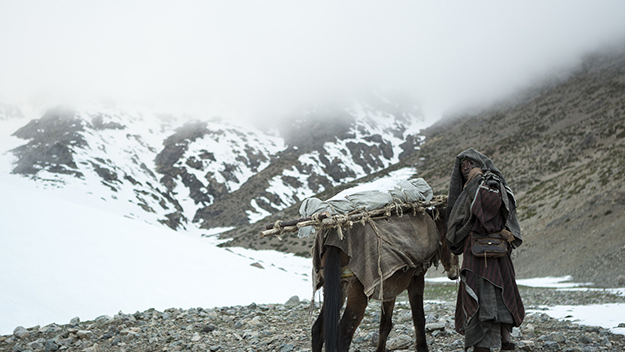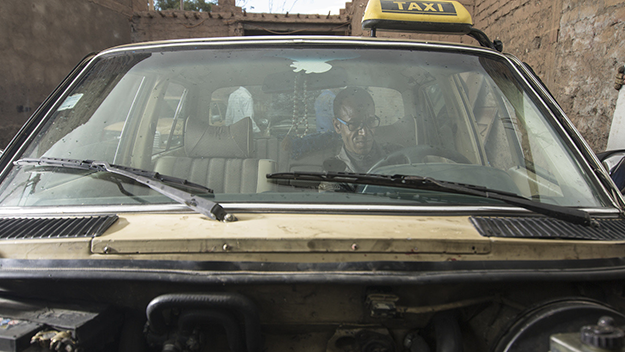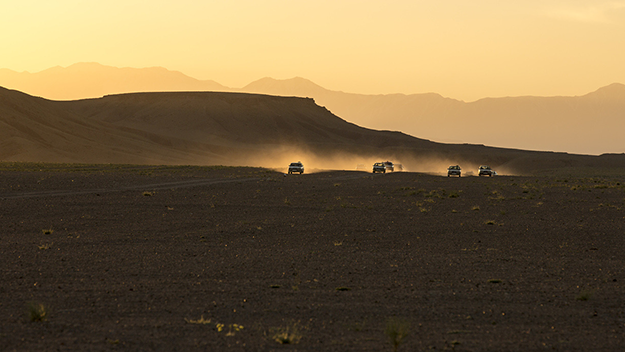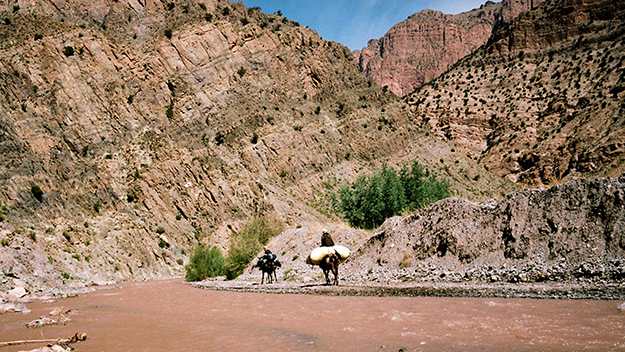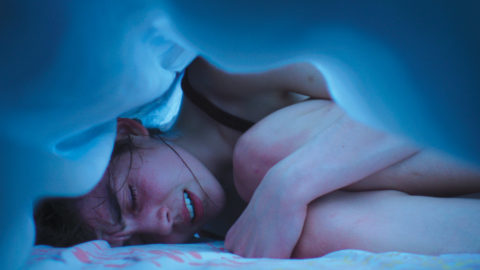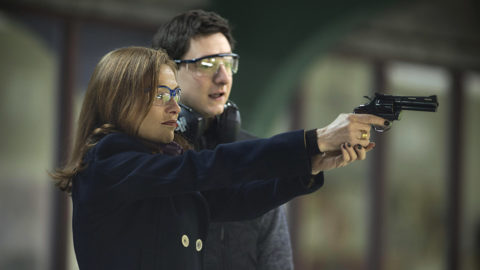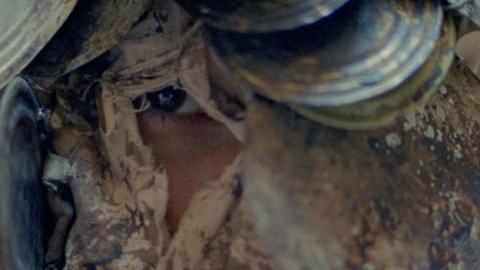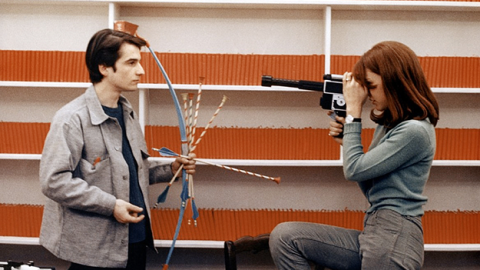Cannes Interview: Oliver Laxe
At Cannes this year, Oliver Laxe’s Mimosas won the Nespresso Grand Prize in the Critics’ Week competition. Laxe’s mystical film imagines two arduous, enigmatic journeys across the desert, one taking place in the present and involving the transport of a sheik’s body, another taking place in a pre-modern past. The territorial progress in each case is overshadowed by the metaphorical and experiential weight of the endeavors, set against unforgiving bare landscapes. (Portions of the film may be familiar to viewers who have seen Ben Rivers’s The Sky Trembles and the Earth is Afraid and the Two Eyes Are Not Brothers.) In Cannes FILM COMMENT spoke with the French-born, Moroccan-based Laxe, also the director of You Are All Captains (10), the day after the world premiere of Mimosas, which is slated for release in the U.S. this winter.
In the introductions to the first screening, a distinction was made between faith and religion.
I belong to a generation of people that are free to confront religion and spirituality without any fears. We are comfortable. But we don’t trust in this world. For me, religion, spirituality, faith are all the same thing: art.
So art can also be a spiritual practice.
For me it’s a religious act. What is religion? What is the etymology of the word “religion”? Religare: to put together, to link. In this movie, I’m linking all the time. Of course, I did that on a Muslim latitude, in a Muslim country, but I went so deep into the essence that anybody from other cultures or spiritual backgrounds can understand it and will identify with it. The structure or geometry of the human heart is the same here, and in—where are you from?
New York. Maybe there’s no heart in New York.
There is! There is! [Laughs] There are a lot of hearts in New York, everywhere you are.
The presence of spirituality in the film is powerful, but it can be both inspiring and a little intimidating. Could you talk about Shakib, the character who is considered blessed?
He’s kind of an angel spirit. He’s a very innocent and pure character. He doesn’t give you a feeling of fear. He’s a child, a man with a child inside, you know? And the way he is, is like a manga cartoon. Or like the Idiot of Dostoevsky or Quixote, or Nasreddin Hodja, one of the archetypes in the Muslim area, the wise idiot. He’s very lucid in his lack of rationality or conscience. He legitimized me to speak about faith in a very light way—to speak about a subject that is so difficult today. Of course, I don’t have a complex about speaking about it. But I do have to tell you about the translation in the subtitles…
Not good?
They talk about God 20 times more than is necessary. Sometimes they don’t say “God,” but it’s translated as “God.” I don’t know. We had a mistake, and they translated the music in the wrong way and the Koran in the wrong way. It was a complete disaster. Yesterday was one of the worst days of my life, because it changed the sense of the film. It’s not like, okay, the color is not good—no, it’s really the sense of something that was very well balanced. Too much got destroyed.
Sometimes the absence of the word conveys more meaning.
Exactly. This was the challenge of the movie, to take the truth, the cinematographical truth, to evoke the mystery, the ineffable. And that, I think, is one of the questions that most filmmakers are trying to understand. We have a lot of examples in the past: Tarkovsky, Dreyer, Ozu, Bresson. How to introduce the ineffable in the cinematographical language. And I’m one of those who thinks that it can be done with the form of paradox. So that’s what I did in the movie.
The spiritual world is not logical, it’s not rational. The rational is one level of interpretation of the world, but it’s not the only one. The problem is when it’s the only one, which happens nowadays. I wanted to use these tools—the geometry of images—in order to create the feeling that there is something behind them, that there is an echo of this mystery of the ineffable. To show that religion is not so exoteric, it’s more esoteric. That is one of the problems of all the religions today. With secularism, religions have been very materialized—they only have the exoteric and literal side, but not the esoteric one, which completes the religion. That’s one of the reasons they’re in crisis today.
It’s interesting that you use the word geometry. One of the most potent visuals in the film is that of cars speeding across the desert on these determined lines.
That is a kind of archetype. There are no cars. You feel something. They are anthropomorphized. It’s like Duel, from Spielberg . . . Now, I’m working on a psychedelic road movie, with French punks and Sufis, in French Mauritania.
How do you work with your cast in conveying the import of this weighty material?
What did you feel?
I felt like they were totally in the moment.
They have been my friends for 10 years. I have beautiful friends, so why use actors? It’s very logical, no? [Laughs] I was touched by them, so I wanted to share that. For me, they are miracles. When I find a fountain of something beautiful and pure, I feel we have to take care of it, we have to share it. So like all filmmakers, I make a spiritual radiography of the soul: what touched me, and why. Ahmed Hammoud—I was touched by his mystery, his scarf, his spiritual scarf, his silence. He is a good friend of mine. His character is a skeptic, but a skeptic because he has a big heart.
And Shakib—when I wrote this script, I knew that putting Shakib on a horse with a plastic sword would work. “I’m going to kill them all! I’m the hero!” [Laughs] He doesn’t know how to read. It’s difficult to work with him. He’s not someone you can give the script who will study it. He cannot act. He has to be himself. He doesn’t know how to act, it’s impossible.
So did you feed him lines or how did that work?
Yeah, I was with him, I put him in the history. He likes action movies.
Being the hero.
Yes, he likes that. And this is a kind of chivalry, a knight’s tale, to be a spiritual knight. In the tradition of King Arthur and the Holy Grail quest. There is an epic tale, there is a physical adventure and also a metaphysical one.
It feels like an interesting mix of traditions, between the knights and the Sufi history.
No, not at all, because all this knighthood tradition comes from Islam. The Sufi orders inspired Spanish mystics and also other mystics from Europe. In the Crusades, they fought, of course, but they exchanged ideas. St. Francis of Assisi exchanged a lot with the Sufi mystics. He has a djellaba, his order. They say Salaam Alaiykum—“Peace be with you”—and they practice the same poverty as a Sufi. Religion is linked. I don’t think they are different traditions. I am Spanish. We are bastards. We are mixed. We are sons of Jews, Muslims…
And today, we are in different times. Globalization is not just for putting companies in Thailand or Bangladesh, you know? It’s also an opportunity to travel on different levels, in art and spirituality. We have this mestizo, mixed-blood conscience. The thing is that we are also artists. I trust in identity, of course. But when you’re an artist and you see a history of culture, you see that culture is a mix of identities. Quixote, Shakespeare, full of exchanges.
How did you shoot the film?
We used the Arri 416, and we shot in Super 16. I really believe we can do independent cinema in an industrial context, and I’m very interested in the American independent cinema of the Seventies—you know, when the studios were interested in putting money into Monte Hellman movies, and all the movies of that era. I think we wanted to have this spirit, with the cars, too. A little bit rock ’n’ roll, American, very pop. We wanted to mix and to take. And of course, remain in a dialogue with the masters—it’s also very European.



